 |
|||||
|
|||||
| Preview of Stamps Catalogue: VOLUME 1 |
 |
|||||
|
|||||
| Preview of Stamps Catalogue: VOLUME 1 |
Return To Catalogue - Barbados 1892-1911 - Barbados 1912-1920 and miscellaneous
Currency: 4 farthings = 1 penny; 12 pence = 1 Shilling; 20 Shillings = 1 Pound
Note: on my website many of the
pictures can not be seen! They are of course present in the catalogue;
contact me if you want to purchase it.
Barbados is a small flat coral island in the Caribbean (size about 20x20 km, situated northeast of Venezuela). It was settled by Great Britain in 1627 and gained independance in 1966.
Imperforate (1/2 p) green (1 p) blue (4 p) red Perforated
(1/2 p) green (1860) (1 p) blue (1860) (4 p) red (1861)
These stamps had no value-indication. Similar stamps were issued in Trinidad.
For the specialist: these stamps were first issued in 1852 on bluish paper (imperforate and no watermark); the values 1/2 p and 1 p were re-issued in 1857 on white paper (imperforate and no watermark). All three stamps were issued perforated in 1861 (still no watermark). The watermark 'large star' was introduced in 1870 for all three values (stamps are perforated). This watermark was changed to 'small star' in 1971 (perforated). Many different perforations exist for these stamps.
Value of the stamps |
|||
vc = very common c = common * = not so common ** = uncommon |
*** = very uncommon R = rare RR = very rare RRR = extremely rare |
||
| Value | Unused | Used | Remarks |
No watermark, imperforate |
|||
| (1/2 p) green | RRR | RRR | blue paper |
| (1/2 p) green | RR | RR | white paper |
| (1 p) blue | R | R | blue paper |
| (1 p) blue | R | R | white paper |
| (4 p) red | RR | RR | blue paper |
No watermark, perforated |
|||
| (1/2 p) green | R | R | |
| (1 p) blue | RR | *** | |
| (4 p) red | RR | RR | |
Watermark 'large star', perforated |
|||
| (1/2 p) green | RR | *** | |
| (1 p) blue | RRR | RR | |
| (4 p) red | RRR | RR | |
Watermark 'small star', perforated |
|||
| (1/2 p) green | RRR | RR | |
| (1 p) blue | RR | *** | |
| (4 p) red | RRR | RR | |
Examples
Examples:
This forgery can easily be detected by the background pattern. A coloured outline can be found all around the stamp, then a white space and then a wave-like pattern. The genuine stamps don't have this pattern. I've been told that these forgeries are engraved and could have been made by the forger Panelli (or actually Oneglia, and only sold by Panelli). I have seen the red stamp with a numeral "1" cancel. Also note the "G" with bars cancel shown on the red stamp above. Similar forgeries were made for Trinidad (in many colours) and Mauritius:



Barbados forgery next to similar forgeries of Trinidad and
Mauritius made by the same forger
Another forgery:
The above forgery has different borders from the genuine stamps. Also the lettering is slightly different. The cancel applied on the forgery on the left was never used in Barbados. I've seen this forgery in the color green as well.




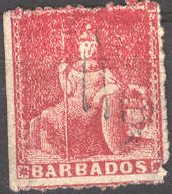
(And some other forgeries, there should be an white outline
around the hair, which is absent in the above forgeries)




(Other blur forgeries, left image obtained from Bill Claghorn's
forgery site)

Some other forgeries of the green stamp.

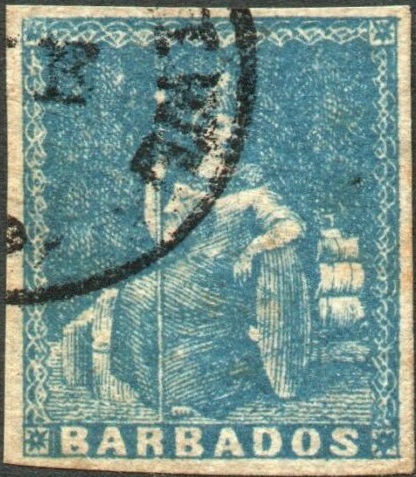
Other forgery with less detail than the genuine stamps. Also note
the weird "S" of "BARBADOS" and the 'shaved
off' bottom part of the first "B". The second forgery
has a VF cancel which can be found
on many forgeries of other countries. .

(A forgery in the wrong colour: black! Image obtained from Bill
Claghorn's forgery site:
http://members.tripod.com/claghorn1p/Barbados/)
In the Fournier Fournier Album of Philatelic Forgeries, the following cancels can be found:
I don't know where this cancel 'BARBADOS 1 JY 7 59' or the numeral cancel '1' was used for.
A nice site with large images of the forgeries of this issue: https://www.barbadosstamps.co.uk/resources/barbados-stamp-forgeries/
Imperforate
6 p red 1 Sh black Perforated
1/2 p green (1874) 1 p blue (1874) 3 p lilac to violet (1873) 4 p red (1875) 6 p red to brown (1861) 6 p orange to yellow (1870) 1 Sh black (1863) 1 Sh violet (1875)
For the specialist: The first stamps with value indication in this type were issued in 1858 (the 6 p red and 1 Sh black); they were imperforated and had no watermark. In 1861 the same two values were re-issued with perforation (but no watermark). All later stamps were perforated. In 1870 the 6 p red and 1 Sh black were issued on watermarked paper ('large star'). In 1871 the same two values together with the 3 p were issued on paper with watermark 'small star'. In 1874 the values 1/2 p green and 1 p blue were issued (on paper with watermark 'large star'). In 1875 a whole set was issued on paper with watermark 'CC crown' (1/2 p, 1 p, 3 p, 4 p, 6 p orange and 1 Sh violet). Of this last set two different perforations exist: 12 1/2 and 14.
Value of the stamps |
|||
vc = very common c = common * = not so common ** = uncommon |
*** = very uncommon R = rare RR = very rare RRR = extremely rare |
||
| Value | Unused | Used | Remarks |
No watermark, imperforate |
|||
| 6 p red | RRR | RRR | |
| 1 Sh black | RRR | RR | |
No watermark, perforated |
|||
| 6 p red | RR | R | two colour shades exist |
| 1 Sh black | RR | R | |
Watermark 'large star' |
|||
| 1/2 p green | RR | R | |
| 1 p blue | RR | R | |
| 6 p red | RRR | RR | |
| 1 Sh black | RRR | R | |
| Watermark 'small star' | |||
| 3 p lilac | RR | RR | |
| 6 p red | RRR | RR | |
| 1 Sh black | RR | R | |
Watermark 'CC crown' |
|||
| 1/2 p green | *** | *** | |
| 1 p blue | RR | ** | |
| 3 p violet | RR | RR | |
| 4 p red | RR | *** | |
| 6 p orange | RRR | RR | |
| 6 p yellow | RR | *** | |
| 1 Sh violet | RR | *** | |
Typical cancels:
The numeral cancels (parish postmarks?)
correspond to the following towns:
1 : St. Michael
2 : Christ Church
3 : St. Philip
4 : St. George
5 : St. John
6 : St. Joseph
7 : St. James
8 : St. Thomas
9 : St. Andrew
10 : St. Peter
11 : St. Lucy
I've seen two types; the number in between lines and the number
in an ellipticly shaped line pattern.
Similar stamps were issued in Trinidad.

Reprint in blue with no value inscription
I've been told that the above reprints are made from the original die impression and made in 1919. They have no value inscription. The blue reprint is printed in a brilliant deep blue shade, on thick wove paper and has no watermark. I've also seen a similar reprint in black which I was told was made in 1929.
I have seen some forgeries of the 6 p value, examples:

Forgery of the 6 p with 'SIX PENCE' not tall enough. I've only
seen it with this cancel (empty in the middle).


Another primitive forgery of the 6 p value. I've seen it with a
lozenge cancel, but also with the cancel as shown in the above
forgery. Maybe they were made by the same forger?
The style of the lettering is different from the genuine stamps in the above forgeries.



Left and center: forgery of the 1 Sh stamp, note the 'S' of
'SHILLING' which is completely different from a genuine stamp.
Right: forgery with the same cancel but with 'ONE SHILLING' not
tall enough.

Cut out illustration, note the strange 'S' in 'SIX'.
5 Sh red Bisected, value cut off and overprinted (1878)


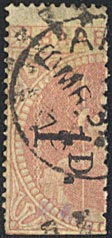

The separation appears to have been done with a sowing machine.
This stamp was issued to avoid a shortage of 1 p stamps.
'1d' on 5 Sh red
For the specialist: This stamp has watermark 'small star' and
is perforated 15 1/2. The centering is often very bad.
The surcharge exists in three types:
type 1: '1' 7 mm high, 'D' 2 3/4 mm high (serif of '1' straight)
type 2: '1' 7 mm high, 'D' 2 3/4 mm high (serif of '1' slanting)
type 3: '1' 6 mm high, 'D' 2 1/2 mm high
Value of the stamps |
|||
vc = very common c = common * = not so common ** = uncommon |
*** = very uncommon R = rare RR = very rare RRR = extremely rare |
||
| Value | Unused | Used | Remarks |
| 5 Sh | RRR | RR | |
| 1 p on 5 Sh | RRR | RRR | |
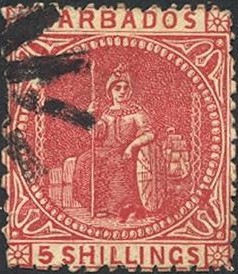
The above forgery is done very clumsily. I've seen it in black color as well with printed perforation (offered as genuine).
I've seen some other very primitive forgeries of this stamp (very blur and clumsily done).


Very blur forgery, letters are touching frame on top. Next to it
a forgery of St.Vincent probably made by the same forger.
A modern forgery exists with the perforation 'squarish'.
1/2 p green 1 p red 2 1/2 p blue 3 p lilac 4 p grey 4 p brown 6 p brown 1 Sh orange 5 Sh yellow Surcharged
'HALF-PENNY' on 4 p brown
For the specialist: these stamps have a watermark 'CA crown'.
Value of the stamps |
|||
vc = very common c = common * = not so common ** = uncommon |
*** = very uncommon R = rare RR = very rare RRR = extremely rare |
||
| Value | Unused | Used | Remarks |
| 1/2 p | * | * | |
| 1 p | *** | * | |
| 2 1/2 p | *** | ** | |
| 3 p | *** | *** | |
| 4 p grey | RR | *** | |
| 4 p brown | *** | ** | |
| 6 p | R | R | |
| 1 Sh | R | R | |
| 5 Sh | RR | RR | |
| 1/2 p on 1 p | * | * | |
The forger Sperati seems to have made a forgery of the 5 Sh stamp. I have no further information concerning this forgery (if you have information, please contact me!):

5 Sh blackprint from Sperati's original negative
According to the BPA handbook, only proofs in black and color exist of this Sperati forgery, but no 'stamps' have been recorded.
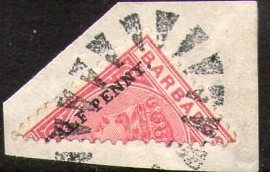
Bogus bisected and surcharged stamp.
A diagonally perforated 1 p, overprinted 'Revenue' and 'HALF PENNY' on each half is bogus (source: The Philatelic Record Vol X, April 1888, No 111, page 71).
For issues of Barbados of 1892-1920 and miscellaneous click here.